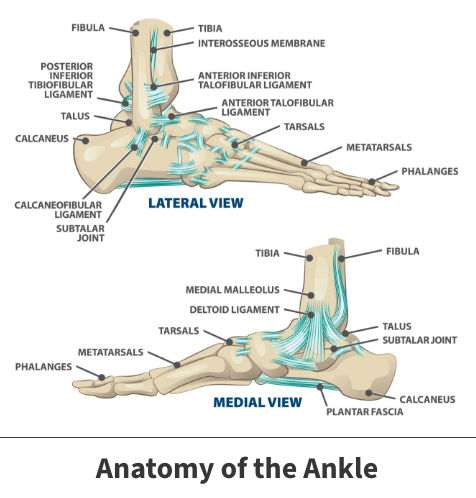Ankle fracture surgery
A broken ankle (also known as an ankle fracture) occurs when one or more of the bones that make up the ankle joint are broken. There are three different bones in your ankle that can break. Sometimes two or all three of your ankle bones can break at once. Depending on the severity and number of broken bones in your ankle, you may need surgery. While surgery for broken ankles varies depending on your specific fracture, all involve using screws and other devices to help stabilize the bones and allow them to heal in the correct position.
Anatomy

Your foot bones are divided into three parts: the hindfoot, midfoot, and forefoot. Seven bones, known as tarsals, make up the hindfoot and midfoot. The calcaneus (heel bone) is the largest of the tarsal bones in the foot. It lies at the back of the foot (hindfoot) below the three bones that make up the ankle joint. These three bones are the:
- Shinbone (Tibia)
- Smaller bone in the lower leg (Fibula)
- Small foot bone that works as a hinge between the tibia and the fibula (Talus)
Together, the calcaneus, heel bone, and the talus form the subtalar joint. The subtalar joint allows side-to-side movement of the hindfoot and is especially crucial for balance on uneven surfaces.
About
A broken ankle is also known as an ankle fracture. It happens when one or more of the bones that makes up the ankle joint are broken. A broken ankle can range from a simple break in just one of the bones to several fractures. The more bones that are broken, the more unstable the ankle becomes. There may be ligaments damaged as well. The ligaments of the ankle hold the ankle bones and joint in position. Depending on the type and severity of your ankle injury, you may not be able put weight on your ankle for a few months and possibly may need surgery.
Several things may cause you to break your ankle, such as:
- Twisting or rotating your ankle
- Tripping or falling
- Rolling your ankle
- Impact during a car accident (or other forceful event)
There are several different types of fractures that each involve special surgical procedures. The different types of fractures are:
- Lateral malleolus fractures – fractures of the fibula bone in the ankle
- Posterior malleolus fractures – fractures of the back of the tibia at the level of the ankle joint. A lateral malleolus fracture may also accompany them.
- Medial malleolus fractures – fractures of the tibia at the inside of the lower leg
- Bimalleolar fractures – fractures where two of the three parts of the ankle are broken
- Trimalleolar fractures – occur when all 3 of the bones in your ankle break

Symptoms
Several common symptoms characterize a broken ankle, such as:
- Immediate and severe pain
- Swelling
- Bruising
- Tender to touch
- Deformity (usually happens if the ankle joint is dislocated as well)
- Inability to put any weight on the injured foot
Surgical procedure
During a lateral malleolus fracture surgery (fracture of the fibula bone in the ankle), the bone fragments are first repositioned (also known as reduced) into their normal position. They are held together with special screws and metal plates attached to the outer surface of the bone. In some cases, a screw or rod inside the bone may be needed to keep the bone fragments together while they heal.
For a posterior malleolus fracture (fracture of the back of the tibia at the ankle joint), the back of the ankle may be unstable depending on how large the broken piece is. To fix this, screws may be placed from the front of the ankle to the back, or vice versa. Another option is to place screws along the back of the shin bone.
During a medial malleolus fracture surgery (fracture of the tibia at the inside of the lower leg), a bone graft may be needed to act as scaffolding for the new bone to grow on if the fracture is impacted. An impacted fracture results with one bone being driven into the other one, typically due to a high force. Depending on the fracture, the bone fragments may be fixed using screws, a plate and screws, or different wiring techniques to help keep the bones in place.
For bimalleolar fractures (when two of the three parts of the ankle are broken), they are treated surgically with the before listed corresponding procedures. The exact surgery your surgeon will perform is dependent on which bones are broken.
Trimalleolar fractures are when all three parts of your ankle are broken. Each of the fractures can be treated with the same surgical techniques before mentioned for each fracture.
Recovery
Because there is such a wide range of injuries, there is also a wide range of how people heal after their injury. It takes at least six weeks for the broken bones to heal. It may take longer for any of the surrounding ligaments and tendons to heal.
You will also need to go through a rehabilitation program of physical therapy to help regain strength and flexibility in your ankle. Your Florida Orthopaedic Institute physician will help determine what program you should follow to help you recover quickly and safely.
Videos
Related specialties
- Achilles Calcific Tendinitis
- Achilles Tendon Rupture
- Achilles Tendonitis
- Ankle Fractures (Broken Ankle)
- Ankle Fusion Surgery
- Arthroscopic Articular Cartilage Repair
- Arthroscopy of the Ankle
- Bunions
- Charcot Joint
- Common Foot Fractures in Athletes
- Foot Stress Fractures
- Hallux Rigidus Surgery - Cheilectomy
- Hammer Toe
- High Ankle Sprain (Syndesmosis Ligament Injury)
- Intraarticular Calcaneal Fracture
- Lisfranc Injuries
- Mallet, Hammer & Claw Toes
- Metatarsalgia
- Neuromas (Foot)
- Plantar Fasciitis
- Sprained Ankle
- Total Ankle Replacement
- Turf Toe
